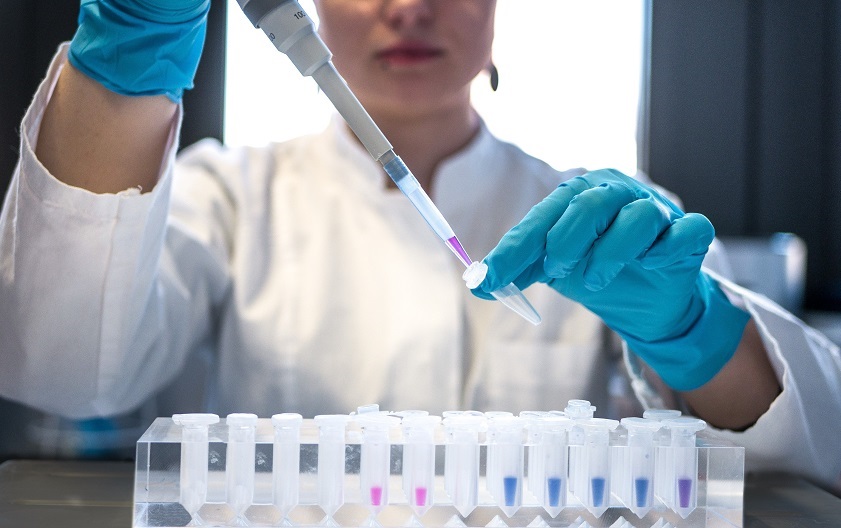
Revolutionary tool could meet future pandemics with accelerated response
A new tool speeds up development of vaccines and other pharmaceutical products by more than one million times while minimizing costs.
In search of pharmaceutical agents such as new vaccines, industry will routinely scan thousands of related candidate molecules. A novel technique allows this to take place on the nano scale, minimizing use of materials and energy. The work is published in the journal Nature Chemistry.
More than 40,000 different molecules can be synthesized and analyzed within an area smaller than a pinhead. The method, developed through a highly interdisciplinary research effort in Denmark, promises to drastically reduce the amounts of material, energy, and economic cost for pharmaceutical companies.
The method works by using soap-like bubbles as nano-containers. With DNA nanotechnology, developed at SDU, multiple ingredients can be mixed within the containers.
One liter instead of all the water in all the oceans
- The technology uses DNA-barcodes similar to barcodes found on all consumer products to follow the identity of all compounds, reagents and chemical reactions carried out in parallel in thousands of ultra small nanoreactors, says SDU team leader Stefan Vogel, Associate Professor at Department of Physics, Chemistry and Pharmacy, University of Southern Denmark.
Head of the team, Nikos Hatzakis, Associate Professor at the Department of Chemistry, University of Copenhagen, further explains:
- The volumes are so small that the use of material can be compared to using one liter of water and one kilogram of material instead of the entire volumes of water in all oceans to test material corresponding to the entire mass of Mount Everest. This is an unprecedented save in effort, material, manpower, and energy.
A new frontier in miniaturized chemistry
Lead author, PhD Student and currently Postdoc researcher at Harvard University, USA. Mette G. Malle, says:
- Saving infinitely amounts of time, energy and manpower would be fundamentally important for any synthesis development and evaluation of pharmaceuticals.
Philipp M. G. Löffler, co-author and Assistant Professor at Department of Physics, Chemistry and Pharmacy, SDU, says:
- It has been tremendously inspiring to see the nanoscale reaction vessels in action under the microscope in the Hatzakis lab: Finding each other, fusing and turning on reactions. The interdisciplinary effort, from DNA-design over microscopy to Machine Learning, is what enabled us open a new frontier in miniaturized chemistry and biochemistry.
Danish collaboration
The work has been carried out in collaboration between the group of Hatzakis, University of Copenhagen, and the group of Associate Professor Stefan Vogel, University of Southern Denmark.
The project has been supported by a Villum Foundation Center of Excellence grant. The resulting solution is named “single particle combinatorial lipidic nanocontainer fusion based on DNA mediated fusion” – abbreviated SPARCLD.
The breakthrough involves integration of elements from normally quite distant disciplines: synthetic biochemistry, nanotechnology, DNA synthesis, combinational chemistry, and even Machine Learning which is an AI (artificial intelligence) discipline.
Results in seven minutes
- No single element in our solution is completely new, but they have never been combined so seamlessly, explains Nikos Hatzakis.
The method provides results within just seven minutes.
- What we have is very close to a live read-out. This means that one can moderate the setup continuously based on the readings adding significant additional value. We expect this to be a key factor for industry wanting to implement the solution, says Mette G. Malle.
Had to keep things hush-hush
The individual researchers in the project have several industry collaborations, yet they do not know which companies may want to implement the new high-throughput method.
- We had to keep things hush-hush since we didn’t want to risk for others to publish something similar before us. Thus, we could not engage in conversations with industry or with other researchers that may use the method in various applications, says Nikos Hatzakis.
Still, he can name some possible applications:
- A safe bet would be that both industry and academic groups involved in synthesis of long molecules such as polymers could be among the first to adopt the method. The same goes for ligands of relevance for pharmaceutical development. A particular beauty of the method is that it can be integrated further, allowing for direct addition of a relevant application.
Here, examples could be RNA strings for the important biotech tool CRISPR, or an alternate for screening and detecting and synthesizing RNA for future pandemic vaccines.
Our setup allows for integrating SPARCLD with post-combinatorial readout for combinations of protein-ligand reactions such as those relevant for use in CRISPR. Only, we have not been able to address this yet, since we wanted to publish our methodology first.
The technology
The SPARCLD method (single particle combinatorial lipidic nanocontainer fusion based on DNA mediated fusion) is a parallelized, multi-step and non-deterministic fusion of individual zepto-liter nano-containers. The research team has observed efficient (more than 93 %) leakage-free fusion sequences for arrays of surface tethered target liposomes with six freely diffusing populations of cargo liposomes, each functionalized with individual lapidated DNA (LiNA) and fluorescent barcoded by distinct ratio of chromophores. Stochastic fusion results in distinct permutation of fusion sequences for each autonomous nano-container. Real-time total internal reflection (TIRF) microscopy allowed direct observation of more than 16,000 fusions and accurate classification of 566 distinct fusion sequences using Machine Learning. The method allows for approximately 42,000 nano-containers per square millimeter.
Meet the researcher
Stefan Vogel is an Associate Professor at Dept. of Physics, Chemistry and Pharmacy.